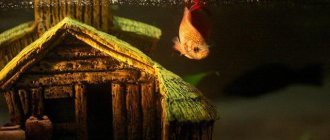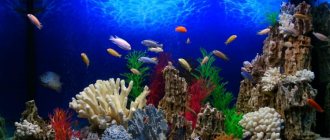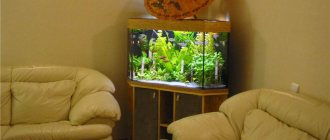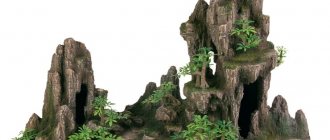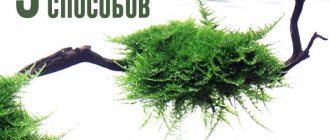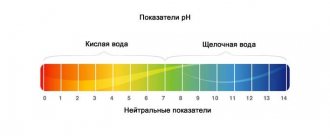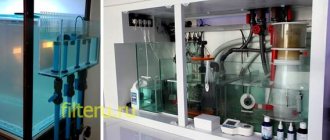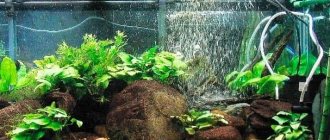Finding and preparing driftwood for an aquarium requires time and knowledge of some subtleties that allow you to decorate the biotope and not spoil the living conditions of its inhabitants.
In this matter, it is easy to make a lot of mistakes that can create serious problems. If an aquarium contains expensive fish or other inhabitants, their lives may be at risk. The issue is serious and requires careful consideration.
What are driftwood needed for?
Driftwood is a common element of the underwater landscape. Aquariums with them look natural and organic. Such compositions invariably attract attention and act as a style-forming element of the room. Plus, by moving the driftwood to a new location, you can quickly change the design of the aquarium.
In addition, driftwood is used as a basis for some plants - for example, mosses and ferns. They grow perfectly onto the rough surface of the wood. Snag with moss looks even more decorative.
A root or branch lying at the bottom can act as a refuge for fry and small fish. Certain types of fish spawn among the roots, and their presence in the aquarium can become a stimulus for the start of spawning of fish. At the same time, natural driftwood always looks more interesting than artificial decorative shelters.
Tannins are gradually released from driftwood into the aquarium water, which slightly oxidizes it and slows down the development of harmful bacteria and viruses. They perform the same functions as leaves that have fallen into a pond in wildlife.
Heaters
Heaters are able to maintain a constant temperature in all layers of water for a long time, which is very important for fish and plants.
Today rod heaters are widely used. They are a glass flask containing a heating element. They are fixed to the wall of the reservoir using rubber suction cups or a metal support.
When choosing a heater, you should give preference to a device with a graduated scale to make it more convenient to regulate the temperature.
What kind of driftwood can you use to decorate an aquarium?
There are several rules:
- It is advisable to choose driftwood for the aquarium from deciduous trees: all fruit trees, willow, maple, alder, poplar, oak;
- preferably hardwood, in central Russia these are willows and oaks;
- it is necessary to use dry wood, not live branches;
- More exotic species are also suitable: beech, ironwood and mangrove; grapevine, mopani, but you will have to buy them in the store.
Filtration
Without a filter, no aquarium can function. This device purifies water from foreign particles, removes dissolved organic compounds from it, promotes water circulation in the aquarium and enriches it with useful substances.
By design, filters are divided into two types:
- Airlift. It is located inside the aquarium, attached to its walls. Consists of a plastic housing, filter material, sprayer and vibration compressor. Water enters the body of the device, where it passes through the cleaning material, getting rid of foreign particles and compounds, and returns to the aquarium.
- Electromechanical filter. They can be fixed both outside and inside the aquarium. They consist of filter material and a centrifugal pump with an electric motor.
Fish needing wood
Most fish species are neutral towards wood in the aquarium. But some people directly need driftwood:
- Several species of catfish require cellulose in their diet. These are panakas, cuckoo catfishes, ancistruses and orinocos. They eat the top soaked layer of wood. Without cellulose, they may even die. It is also necessary for aquarium cleaners - theodoxus snails and some shrimp.
- Moray eels and eels in nature live among tree trunks that have fallen into the water. There they rest and wait for prey. And in an aquarium among driftwood they will feel more comfortable and calm.
- Glassfish and various gourami like to spawn among the branches.
Lighting
High-quality lighting is necessary not only for fish, but also for plants. When selecting such devices, you should take into account the individual characteristics of each fish, since different species need different amounts of light per day and its different intensity. Therefore, it is better to immediately populate the aquarium with animals that are similar in conditions of detention.
For lighting it is better to use fluorescent lamps. They use electricity more economically and, due to their length, cover a larger area of the aquarium.
It is better to attach lighting fixtures to the lid of the aquarium.
The optimal lamp power, suitable for most fish species, is 0.5 W per liter, and the luminous flux is 30 - 50 lm per liter.
How to prepare driftwood for an aquarium?
Preparing driftwood with your own hands is a fairly lengthy, but not complicated process, consisting of several stages.
Cleansing
The selected tree must be completely cleaned of bark, soil and various contaminants and lightly sanded. To do this, it is best to use metal or any other hard brushes and sandpaper. At the same stage, the tree is given the desired shape by sawing off excess length or completely unnecessary branches. It is also necessary to clean off all sharp edges.
Pre-soak
It is necessary to completely immerse the driftwood in water, where it is soaked for 15-20 days. This is done to saturate the natural wood with liquid and wash out the remaining resin and contaminants, as well as excess tannins, from its structure. During soaking, the water must be changed daily. In the case of treatment with salt or chlorine, soaking is best done after the main treatment. It should be carried out until the tree begins to sink on its own.
Salt treatment
A highly concentrated salt solution is lethal to most microorganisms, especially those found in fresh water bodies. The whole driftwood is immersed in a salt solution with a concentration of at least 4 teaspoons per liter of water. Processing lasts about a week.
Treatment with active chlorine
Its principle is the same as when disinfecting tap water. In this case, the branch is placed in a container filled with water and bleach. The easiest way to source it is to take a regular solution of Whiteness at the rate of 1.5 milliliters per 20 liters of water. The process must be carried out over three to four days.
Boiling or boiling
This is the easiest and fastest option if the snag is relatively compact and there is a pan or bucket for this purpose that you don’t mind. The container should not be made of galvanized or aluminum. The driftwood is boiled in a salt solution, preferably with soda, for 5-10 hours. Take one hundred grams of salt per liter of water. After boiling, the driftwood is placed in running water for a day or two or changed every 2-3 hours.
Calcination
The driftwood is placed in an oven at a temperature of 200 degrees and calcined for 2-3 hours. This allows you to disinfect and dry the raw wood. But the main thing here is not to overdry, otherwise the wood will begin to crumble.
IMPORTANT! Keep an eye on the oven, otherwise igniting dry wood may cause a fire.
Installing equipment
A biological environment acceptable for the inhabitants of the aquarium is created using equipment. It provides oxygen, warmth, and creates conditions for normal life.
Filter
There are 2 large types of filters: for internal and external installation. They pass water, purifying it from mechanical impurities and toxic substances. The manufacturer indicates how much water the filter is designed for. They always take extra.
Internal filters are used mainly in small aquariums. The external ones are installed on the bedside table, only the tubes are lowered into the water. Such equipment is more efficient; it has multi-stage water purification. In addition, they are invisible and do not spoil the internal design of the aquarium.
Heater with thermostat
Heater in an aquarium.
The correct selection and installation of the heater affects the comfort of the occupants. It is entrusted with the function of maintaining the desired temperature. At the top there is a thermostat that automatically maintains the set parameters. Power is selected according to the volume of the container. The heater is completely immersed in water, and only then is it connected to electricity.
Automation cannot be completely trusted. If the heater breaks down, it is not visible visually. There are 2 dangers: the heater has burned out or the thermostat does not turn it off. To insure yourself against unpleasant consequences, install a thermometer to monitor the water temperature.
Lighting
For plants, lighting with rays of a special spectrum is important. Special lamps are installed at a rate of 6 W per 10 liters. It is better to increase the lighting intensity by 1.5 times, i.e. bring to 9 W per 10 liters of water. Additional lamps can be installed simpler, for example household fluorescent or LED.
To avoid having to turn on the lights manually, connect the light bulbs via a timer. This could be a socket with built-in automation or a special device.
Compressor
The compressor enriches the water with oxygen, which all living things breathe; it is needed for the decomposition of organic matter. It is installed outside, the tubes are lowered into the water. They are hidden behind plants, decor, under the ground so that only air bubbles rising to the top are visible. The compressor must be mounted above the water level, and if below, it must be equipped with a check valve. Otherwise, if the power goes out, water may flow into the compressor, causing it to break.
Carbonation system
Carbon dioxide saturation.
Plants need carbon dioxide to grow, especially when there are large numbers of fish. All nutrients are always present in water and appear as waste products of fish. There is never enough carbon dioxide.
Enrichment of water with it is carried out in 3 ways:
- Fermenting. An older version of this method is yeast and sugar. Today, special bottled products and all the necessary equipment are offered for sale. The contents are enough for a month.
- Chemical. Previously, soda, eggshells, lime, etc. were used. with acetic or citric acid. The reaction takes place in a special installation - a Kipp apparatus. Now they produce tablets that, when dissolved, release carbon dioxide. The method is not widely used due to the complexity of adjusting the process.
- Mechanical. They use cans, from which they fill a special bell-shaped device in the morning. The gas gradually comes out, feeding the plants. Cans with a capacity of 100-500 ml.
How to fix driftwood in an aquarium?
It is advisable to place driftwood in the aquarium in several different positions and choose the optimal one. Focus on your taste. Now all that remains is to secure them.
In general, properly prepared wood is heavier than water. But this doesn't always happen. Too large driftwood can be lighter than water even after soaking for several weeks. There are several ways to fix them:
- the simplest thing is to tie a snag with a fishing line to the stones on opposite sides; It is advisable to bury it at one end - this way it will look more natural;
- you can screw metal weights to the ends of the driftwood and then decorate them; The main thing here is to select stainless materials with sufficient weight;
- the most difficult thing is to drill holes and fill them with tin; such weighting will look as inconspicuous as possible.
IMPORTANT: you should not allow a position in which both ends of the driftwood rest against the walls of the aquarium located opposite each other. Wood can swell, expand and squeeze out glass.
Useful tips
A few recommendations from experienced aquarists will help you avoid mistakes and decorate your tank in the most effective way:
- When choosing driftwood in a pet store, you need to clarify its purpose. If it is for reptiles, it is not recommended to buy it - such elements are treated with fungicides that are harmful to fish;
- Instead of long-term boiling, the driftwood can be kept in the oven for a couple of hours at a temperature of 200-250°. This procedure will ensure complete removal of moisture from solid wood and eliminate harmful bacteria that may live on the surface and in cracks of the material. The only disadvantage of this method is that the problem of buoyancy is not solved;
- You should not try to fix a floating snag by simply pressing it down with a stone or other heavy object. Sooner or later it will move, and what the consequences will be is difficult to predict.
Some users claim that you can use any driftwood without prior preparation. Perhaps this is not too far from the truth.
However, if the aquarium contains rare and expensive fish, no one will want to take risks. If you are not sure, it is better to prepare, clean and boil the driftwood to protect the inhabitants of the aquarium from trouble.
Additional decor
Driftwood decorated with Java moss and similar plants look very organic. Such a design can create absolutely stunning compositions. You can fix moss to wood using one of the following methods:
- tying with thread is the most environmentally friendly way; the thread will gradually rot, and the moss will grow to the wood during this time;
- tying with fishing line is the most reliable way;
- gluing with glue is, of course, the most convenient, but you need to know the composition and properties of the glue so as not to damage the moss and fish.
Possible problems
In the process of preparing and using driftwood in an aquarium, the following problems may arise:
- The snag does not fit into the pan or oven. A rhizome or branch that is too large can be boiled by lowering it into a container with different ends alternately or cutting it into several smaller pieces. And after you have processed it, all that remains is to assemble it back onto wooden dowels or studs, aluminum or stainless steel. It is not advisable to use iron, brass, or bronze - they will quickly oxidize in water. The junction area then needs to be decorated.
- Bacterial outbreak with strong coloration of water. The cause may be a freshly cut or insufficiently dried tree. It is necessary to dry the driftwood, change the water and add activated carbon to it.
- The snag is covered with mold or a whitish coating. If this happens immediately after diving, this is normal. The plaque will be eaten by catfish, or you can simply wash it off under running water. If the tree has been lying there for a long time, and just now a plaque has appeared, perhaps the wood has begun to actively rot, and should be gotten rid of.
- The driftwood in the aquarium has turned green. Greenery is algae that has covered the surface of the tree. They also cover the aquarium walls, pebbles and decorations. The reason is excess light. You can get rid of greenery by simply cleaning the driftwood.
Site selection and preparation
They choose a place taking into account the interests of the residents and the characteristics of the inhabitants of the aquarium. It is recommended to adhere to the installation rules:
- Keep away from direct sunlight, otherwise green algae will begin to rapidly develop and the water will bloom.
- Further from the door, so as not to frighten the fish with the constant movement of residents.
- Not near a heating radiator or household appliances.
- So that no one accidentally touches it - the aquarium should not interfere with free movement around the apartment.
The most suitable place is the living room in a large apartment or the kitchen in a small one. The bedroom is not suitable for everyone - the compressor is noisy, which can disturb sleep.
It is better to purchase a special cabinet for the aquarium that will support its weight. A rubber mat is placed on the tabletop. Check horizontality carefully. The larger the volume of the artificial reservoir, the more accurately the stand is set. Make sure the floor is strong. The stand is placed at some distance from the wall in order to supply power cords.
The container is first checked for leaks and strength. Fill the water up to half, and after a while completely. After a day they inspect: there should be no moisture anywhere on the outside. The test also makes sure that the glass will withstand the load and will not burst.
Then drain the water and wash the aquarium without special products - only soda is allowed. Rinse repeatedly, wipe dry and leave to dry.


